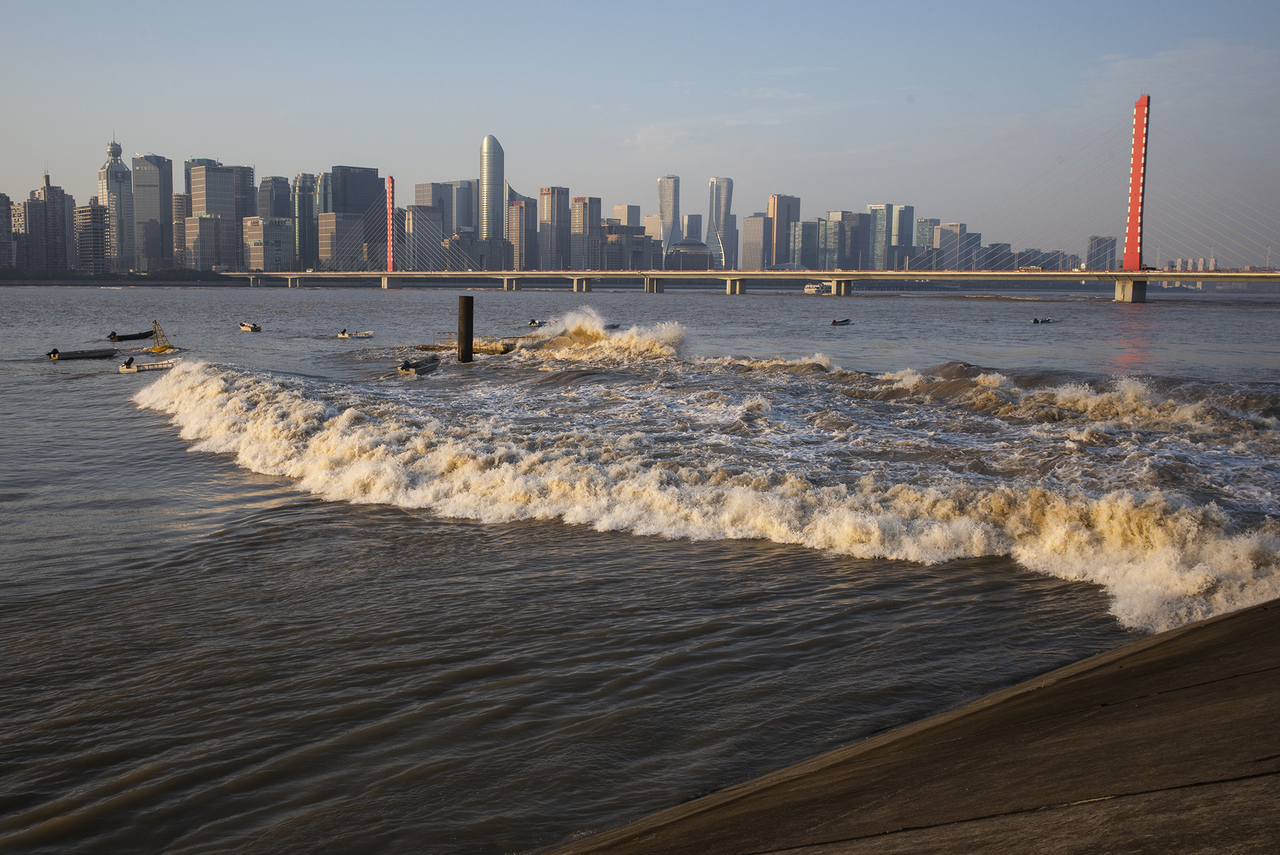"Zhejiang Cultural Imprints" is a series of introductory articles introducing some of the most influential cultural heritages and cultural imprints in Zhejiang province. Today, we'd like to bring the story of Qiantang River Tidal Bore to you. It is a tidal bore with its own festival here in Zhejiang.

(Qiantang River Tidal Bore)
The rising tidal coming from the Hangzhou Bay is funneled by the shape of the Qiantang River into the world’s largest tidal bore, a long breaking wave that sometimes reaches 30 feet high.
The spectacular Qiantang River Tidal Bore is known as one of the largest tidal bores in the world. It is annual and usually starts at the beginning of the eighth lunar month. The trumpet-shaped mouth of the Qiantang River, combined with the gravitation of the celestial bodies and the centrifugal force produced by the rotation of the earth helps generate the extraordinary tidal waves it is famous for, say experts.
The Qiantang tide has been well documented since ancient times.
As early as the fourth century BC, famous philosopher Zhuang Zi once described the huge tide as follows: "The waters in the Qiantang River will roll on, raising waves as high as mountains and towers, creating a thunderous roar and gathering up a force that threatens to engulf the sun and the sky."
The observation of Su Dongpo, a famous Northern Song Dynasty (960-1127) poet, ran thus:
"What on earth can hope to create a spectacular sight,
Like the tides on the eighteenth of August at night."
Tide watching on the Qiantang has been a popular activity for centuries, dating back to the Han Dynasty (206BC-AD220). By the time of the Southern Song Dynasty (1127-1279), it had become a well-established event on the social calendar for both ordinary people and the royal court.
The Southern Song government once made a rule to parade its naval forces in the Qiantang River on the 18th day of the eighth lunar month, an event that later developed into the Tide Watching Festival.
Miles of tents and viewing platforms are erected along the banks of the river for the weeklong event, which takes place during the Mid Autumn Festival.
During the festival, brave and expert swimmers line up to test their valor against the might of the tide each year.
The Qiantang River tide occurs between the 1st and 5th, and the 16th and 20th of each lunar month, while the most breathtaking one occurs on the 18th day of the eighth lunar month.
When thrill-seekers gather on the stone-paved seawall on the day of the tidal bore, they will initially see a tranquil scene with the river placidly flowing eastward with some seagulls soaring gracefully in the distance.
By 1:00 pm, a thin silver band will, all of a sudden, appear on the river in the far distance, very faint, if visible at all, along with a succession of murmuring sounds.
The thin silver band will then become wider and wider and rise higher and higher, looking as though a myriad of silvery-white fish were flopping about in ceaseless tumbles or like a huge flock of white swan flapping their wings in upward flight and then moving in and swooping down.
Meanwhile, the slight murmurs will have intensified, sounding now like roaring thunder that sets the earth vibrating.
Then the bore will come still nearer, with a crest that looks like a 3 or 4m-high wall spouting pearls and jade beads every which way, until it comes crashing down Just when you have managed to regain your senses and summoned up enough courage for a closer look, it will already have gone past you, at a rate of 10m per second. What is left before you is the sight of the swollen river stretching for miles without end.
Qiantang tidal bore watching is as popular now as it was 2,000 years ago.
This year, the Qiantang River Tide Watching Festival is to be held from 27 to 29 September.
The vantage point for watching the tide has changed over the centuries due to gradual changes in the river's course as well as in the intensity of the tide.
In the Song Dynasty (960-1279), the best site to watch the tide bore was the 5-km stretch of riverbank that now lies between Miaozitou and the Six Harmonies Pagoda.
With the passage of time and the changes it brings, the best spot to get a view of the tidal bore has shifted now to a section of the seawall at Yanguan township in Haining County, where a number of ancient architectural structures still stand.
Given the Qiantang River's fluctuating water volume and the reclamation of a considerable amount of riverbed near its mouth, a section of the riverbank in Xiaoshan district has also become a favorite tidal bore-watching site.
The tide viewing sites in the Hangzhou city area include Qiantang River Bridge and along Zhijiang Road below the Six Harmonies Pagoda. However, the best places to view the tide are in Xiaoshan district and Yanguan township in Haining county, which has specially designated viewing platforms and is both located less than 50 km from Hangzhou.




